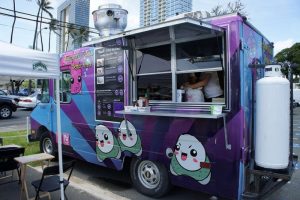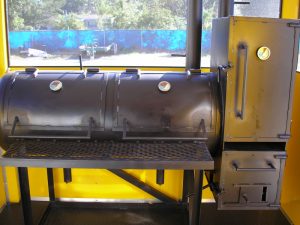Hey there, food truckers! With the mercury climbing, it’s crucial to keep both you and your team cool as you crank out your menu. Let’s dive into some tried-and-true methods to beat the heat and ensure your food truck isn’t just a rolling sauna.
1. Ventilation is Key
When you’re cooking up a storm in a small space, things get hot fast. Really hot. Good ventilation keeps the air moving, making it less like a sauna and more like a comfortable kitchen. This isn’t just about comfort; it’s about making sure you and your team can work without feeling like you’re melting. Happy cooks make better food!
And as you already know, cooking generates not just heat but smoke and fumes too. Some of these can be harmful if you breathe them in for too long. A top-notch ventilation system pulls all that bad air out and keeps the air inside the truck clean and safe to breathe. Think of it as a health shield for everyone inside.
Of course there are reasons beyond heat to install a quality ventilation system. Cooking also produces a lot of steam. Without proper ventilation, this moisture builds up inside, leading to condensation on walls, ceilings, and equipment. Over time, this can cause mold and mildew, which are not only health hazards but can also damage your truck’s interior. Good exhaust fans help keep the air dry and your truck in top condition.

Food trucks can get hot in the summer.
2. Shade and Awnings: Block the Sun’s Blaze
Imagine standing directly under the noon sun in the middle of July. It’s brutal, right? Now, think of your food truck the same way. When it’s exposed to direct sunlight, it absorbs all that heat, making the inside feel like an oven. Awnings act like a big, protective hat for your truck. They block that direct sunlight, significantly reducing the amount of heat your truck absorbs.
With awnings providing shade, the temperature inside your truck doesn’t climb as high either. This means your air conditioning (if you have it) doesn’t have to work as hard, and your fans can circulate air that’s not superheated. It’s all about keeping the inside of your truck from turning into a hotbox, which keeps you and your crew from overheating.
3. Hydration Station
This one’s a no-brainer but easily overlooked in the hustle and bustle. Keep a cooler stocked with ice-cold water for you and your team. Staying hydrated is crucial when you’re working in a hot kitchen. Consider offering water to your customers too; they’ll appreciate the gesture on those hot summer days.
In a hot food truck environment, you’re sweating more than usual, which means you need to drink more water to keep up. Keeping a cooler of ice-cold water easily accessible encourages everyone to drink regularly, helping to prevent dehydration.
Knowing the signs of overheating is crucial. Symptoms can include excessive sweating, weakness, cold, pale and clammy skin, a fast or weak pulse, nausea or vomiting, and fainting. If you or someone on your team starts showing these symptoms, it’s important to act quickly: move to a cooler place, sip water, and rest. Ignoring these signs can lead to heat exhaustion or heat stroke, which are serious health emergencies.
4. Light-Colored Paint and Reflective Surfaces
Did you know the color of your truck can affect the inside temperature? Lighter colors reflect sunlight, while darker ones absorb it, turning your food truck into an oven. If you’re due for a paint job, consider going for a lighter shade. Adding reflective materials to your roof can also deflect some of that heat away from your mobile kitchen.
5. Dress Appropriately
It might seem simple, but wearing light-colored, breathable fabrics can make a significant difference in how you feel during a long, hot day. Invest in some good-quality, moisture-wicking clothing to help keep the sweat at bay.
6. Use Smaller, Efficient Appliances
Where possible, opt for modern, energy-efficient appliances. They tend to generate less heat and use less energy, which can help keep the interior of your truck cooler. Plus, they’re better for the environment and your wallet in the long run.
8. Schedule Smart
If you can, try to plan your prep work during the cooler parts of the day. Getting started early in the morning or doing prep work late at night can help you avoid the peak heat times. Also, consider locations that offer natural shade for those midday hours.
In addition to scheduling, switching up your menu for the summer can be a cool move in more ways than one. When you think about cooking on a grill or a stove, it generates a lot of heat. Not just the food gets hot, but the whole truck does, too. Now, imagine instead of flipping burgers on a sizzling grill, you’re assembling fresh salads. The difference is night and day. Salads and other cold dishes don’t require cooking, which means you’re not adding extra heat to your already warm food truck environment. It’s like choosing to stay in the shade instead of standing in direct sunlight.

Grilling in the summer heat? You’ll want a quality ventilation system.
9. Air Conditioning: Not as cool as you think?
Adding an air conditioner to a food truck sounds like a great way to keep cool, right? But it’s not as effective as it sounds. In most food trucks, the AC will keep a mobile kitchen cool until the cooking in the kitchen starts, which is when you’d like to to work the most. Here’s why:
The fan that pulls smoke and hot air out of the truck (called the hood exhaust) can also end up pulling out all the cool air from your air conditioner. It’s like trying to fill up a bathtub with the drain open. You keep adding cold air, but it keeps getting sucked away.
On really hot days, especially if the sun is beating down on the truck, the air conditioner might struggle to keep things cool inside. And every time someone opens the window to serve customers, all that cool air escapes, making it even harder to keep the inside comfortable.
So, what can food truck owners do?
- Think about where to put fans and vents so they don’t fight with the air conditioner.
- Choose an air conditioner that doesn’t eat up too much power.
- Improve the truck’s insulation or use special paint to reflect sunlight and keep the truck cooler.
- Plan food prep for cooler times of the day and maybe use other cooling gadgets like small fans during the busiest, hottest hours.
- Talk to an experienced builder like M&R Specialty Trailers and Trucks to make sure you’ve got a well-thought out mobile kitchen that will keep you cool on the hottest days.
Adding an air conditioner to a food truck is a bit like solving a puzzle. It’s about balancing the need to stay cool with the practical stuff like power, space, and costs.
Closing Thoughts
Inexperienced vendors often overlook how hot it can really get on a food truck during the hottest months usually from June – September. But with a little preparation and some smart investments in your truck’s setup, you can create a cooler, more comfortable working environment for you and your team. Stay cool, stay hydrated, and let’s make this summer your truck’s best season yet!

Leave A Comment